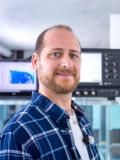Francesco Messi

Francesco Messi
Francesco Messi graduated in Physics with a specialization in Electronics and Cybernetics, at the University of Rome "La Sapienza", Italy in September 2007 and earned his PhD in Particle Physics at the University of Bonn, Germany in May 2015. Currently, Francesco is a researcher at Lund University, Sweden, collaborating with the Detector Group of the European Spallation Source on the development of new technology neutron-detectors.
- Since my arrival at Lund University, I have been working on the Multi-Blade project and on the developing of the Source Testing Facility (STF). The Multi-Blade is the designated detector technology for the neutron reflectometer instruments at ESS. Our main task is to face the challenge of high counting rate and high spatial resolution needed for the new instruments at ESS. The Source Testing Facility is the place where all ESS new prototypes see their first neutron. Being located at Lund University, the STF is also hosting several student laboratories for courses of physics and engineering.
My daily tasks are different and various. I may start my day in front a computer designing printed circuit boards (PCBs) and finish it in the laboratory, fixing a prototype detector with tape and glue during a test; working at the frontier of research, we often have to develop all our tools, being not available on the market a good solution. As researcher at the university, I also have teaching duty. Apart from the time in which I am involved in courses, students are often coming to me for advice, corrections and/or supervision.
On top of that, traveling plays a big role in my working days. This includes performing tests in existing neutron facilities as well as participating in meeting and conferences. To meet other scientist and share the obtained results is a must in science and in particular in the R&D of new detectors.
What I like most about the BrightnESS project is the network of scientists and students as well as the freedom of sharing problems and results.
One of our challenges is that fixed deadlines are not always possible to meet in R&D and research, but it helps focusing on one problem at time and to avoid overdoing: with infinite time (and infinite resources) any detector would be perfect, but in a real world, we are called to do our best in the time and resources assigned.
Giving the opportunity of travel and meet other scientist, as well as provide a secure budget for the R&D of new prototypes, BrightnESS has definitely contributed to enrich the neutron community as well as to develop new detector technologies.

 is funded by the European Union Framework Programme for Research and Innovation Horizon 2020, under grant agreement 676548.
is funded by the European Union Framework Programme for Research and Innovation Horizon 2020, under grant agreement 676548.